Basics of an Escape Room
| Site: | Vitajte v prostredí e-learningu na Filozofickej fakulte PU |
| Course: | ELT: DASS Online Digital Tools |
| Book: | Basics of an Escape Room |
| Printed by: | Hosťovský používateľ |
| Date: | Tuesday, 18 November 2025, 3:11 AM |
1. What is an Escape Room?
An escape room is usually a physical adventure game, in which players solve a series of puzzles and riddles using clues, hints, and strategy to complete the objectives at hand. The primary goal is to "escape" from a locked room within a set time limit. Escape rooms are designed to be immersive and engaging, often featuring a thematic storyline or scenario that adds to the overall experience. Online escape rooms are digital versions of real-life escape room experiences, which happen in a virtual world. Online escape rooms in an educational activity involve students working collaboratively to solve a series of educational challenges, puzzles, or tasks within a set timeframe. The goal is not to physically escape a room but to accomplish specific learning objectives or demonstrate mastery of a subject matter. Educational escape rooms serve as an innovative and interactive teaching tool, aiming to make learning more enjoyable, memorable, and collaborative. They align with modern pedagogical approaches that emphasize active learning, student engagement, and the development of 21st-century skills.
2. Advantages of Escape Rooms
Teamwork and collaboration – Improving communication and interpersonal skills among students, who work together to solve puzzles and achieve a common goal.
Critical thinking – Students need to analyse information, make decisions, and think critically to succeed in escape rooms. This leads to the development of critical thinking abilities, which are valuable in various academic subjects and real-life situations.
Time management – Escape rooms often have a time limit, which encourages students to manage their time effectively.
Motivation and Engagement – Escape rooms in teaching can make learning more enjoyable and engaging for students. As it serves as a motivational tool, it can motivate students to actively participate in the learning process.
Self-control – The students have set instructions and rules, that they must follow.
Creativity and Imagination – Escape rooms often feature storylines and puzzles that require imaginative thinking. Engaging in these activities encourages students to think outside the box.
Social Interaction – Beneficial in remote learning environments, fostering a sense of community and connection among participants. The students can discover and find their group roles through the activities.
Stress Relief and Fun – Engaging in an online escape room can provide a break from traditional learning methods. It offers a fun and enjoyable experience, that potentially reduces stress levels and also has an educative potential.
3. Disadvantages of Escape Rooms
Complicated organisation – The online escape rooms are difficult to organise. The organisation includes time, place, and maintaining discipline in class.
Technical issues – Online escape rooms require an internet connection, which may lead to internet connectivity problems, or compatibility issues with different devices.
Distraction – Students may face distractions when participating in online escape rooms, mainly if they are not closely monitored. The temptation to multitask or engage in unrelated activities can lower the effectiveness of the lesson.
Lack of physical activity – Physical escape rooms often involve movement and exploration of physical space, while online escape rooms may lack this aspect.
Limited creativity in design – Some online escape rooms may not offer the same level of creativity and design as physical escape rooms, because the virtual environment may impose limitations on the variety of puzzles and challenges.
Overuse of gamification – Gamification can enhance engagement, but an overemphasis on game-like elements may divert attention away from the educational goals.
Students “blend in” – Some students may not actively participate in an activity. The students simply wait for others to finish the task for them.
4. Methodological and Technical Advice
This chapter consists of Do´s when dealing with online escape rooms.
Methodological advice:
1. Choose a captivating theme, that would be interesting for players.
2. Create a storyline that provides context and purpose for solving puzzles, also do not forget the didactic function of the activity!
3. Design a variety of puzzles with varying difficulty levels.
4. Plan the flow of the game, and ensure logical progression – each solved puzzle leads to the next challenge.
5. Encourage teamwork by designing puzzles that require collaboration, for example, include elements, where participants must share information to progress).
6. Set a time limit for the escape room, but include time extensions or hits for participants who may struggle with certain puzzles.
7. Test the escape room with multiple groups to identify potential issues. You can test the escape room on your co-workers, friends, etc.
8. Collect feedback from participants and learn some interesting ideas, tips you might use while creating other online escape rooms!
Technical advice:
1. Choose a reliable and user-friendly platform, if you are hosting an online escape room. Consider platforms with features like video conferencing, screen sharing, and chat.
2. Check, whether the video and audio are of good quality -> better to test the equipment and settings before you start, to avoid technical issues.
3. Use interactive tools and platforms for puzzles (e.g., Google Forms, Genially, ...). Combine multimedia elements such as images, videos, and sounds. Use a variety of questions (open-ended, close-ended, etc.).
4. Implement measures to prevent cheating.
5. Have a backup plan (backup puzzles, alternative paths, etc.) in case of server issues or participant connectivity problems.
5. Methodological and Technical Awares
This chapter consists of Don´ts when dealing with online escape rooms.
Methodological Don´ts
1. Don't make the escape room too different from the lesson plan and goal. Make sure the puzzles and challenges help students with what they're supposed to understand.
2. Don't start the escape room without getting everything ready. Make sure all the clues and instructions are organized and ready to use.
3. Don't start without telling students what to do. Explain the rules and why they're doing the escape room.
4. Don't forget about how everyone is working in the group. Make sure everyone is taking part and doing something.
5. Don't finish the escape room without talking about what students learned and the students´ feedback. Use the time after to discuss what you found out and ask any questions.
6. Don't stick too much to the plan if things aren't going as expected. Be ready to change things based on what helps students learn.
Technical Don´ts
1. Make sure not to use technology that might be too difficult for everyone to understand, especially for young learners even if they are connected with technologies in everyday life.
2. Before the activity, test all the technical stuff, like software and equipment. Although you think you are prepared, be ready for any technical problems and have a plan for what to do.
3. Remember that not everyone knows a lot about technology. Help those who need it and teach them how to use the technology.
4. Make sure everyone, including those with disabilities, can use the technology. Have other ways for people to get information if they can't use the technology.
5. Consider how much time it takes for people to use the technology in the activity. Don't make it too complicated – keep things moving.
6. Even though it's fun, don't forget the reason you're doing the activity – to learn.
7. Make sure the technology helps people learn and doesn't just make things look cool.
6. How to Create an Escape Room
In this chapter, you can find instruction on how to create an escape room in Google Froms.
Creating an Escape Room!
1. The first step of creating an Escape Room is to decide on a theme and storyline. For example, “A Castle Escape” where the players are stuck in a castle and their objective is to escape a hungry dragon.
2. Go to Google Disc and click on “New”

A choice of options should appear, click on a small arrow on the edge of the Google Forms option, and then click on the “Blank form”

3. You
can rename your escape room and add a little story about it in the first 2 text
fields.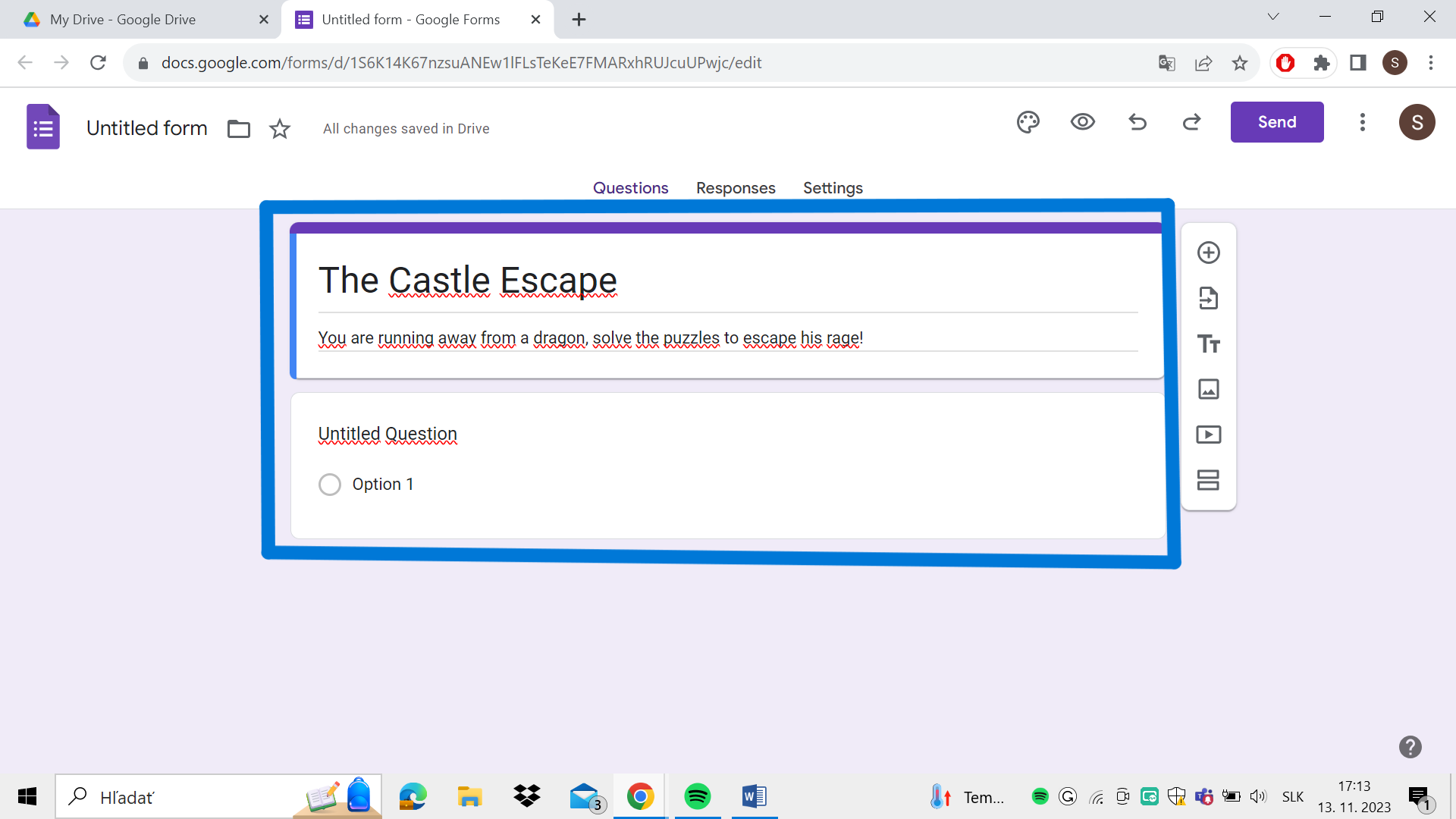
4. Now create sections, they serve as different “rooms” in your escape room game. To create a section, click on the two horizontal rectangles on the right panel.

Create how many sections you want, depending on how many rooms/activities you want to have in your Escape Room.
5. Each section is marked by a number and can have its own name and story, which you can add. You can also add a little hint to help the participants figure out the answer.

6. To create a task, click on the one from the following list on the right. The options provided are: “Add question, Import questions, Add title and description, Add image, Add video”, and “Add section” which we already used. The simplest tasks are created by “Add question”.
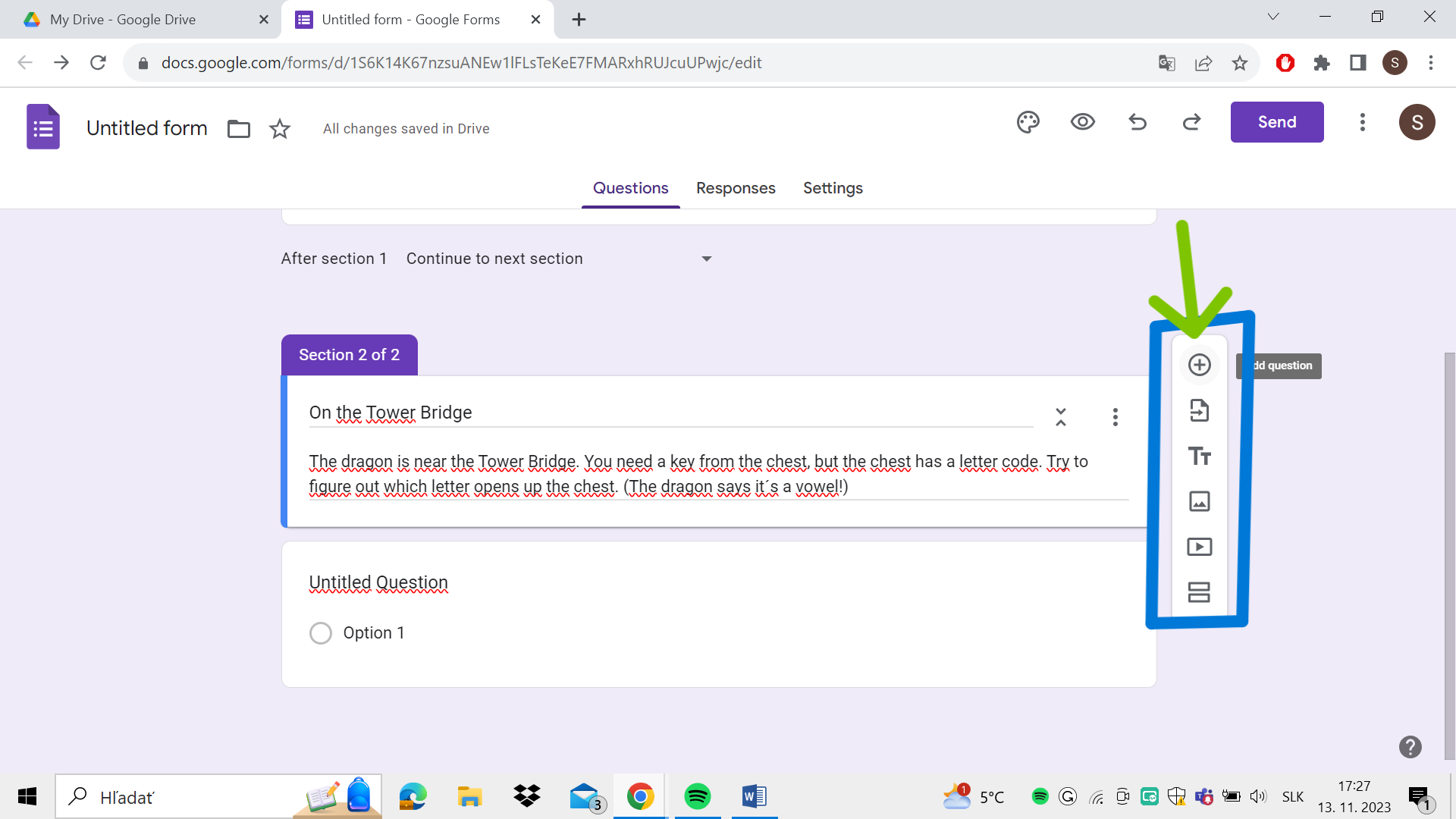
7. Now that you created a question, you can add the question itself. Choose what kind of answers you want from the “Multiple choice” box. Don’t forget to tick “Required” under ALL QUESTIONS.
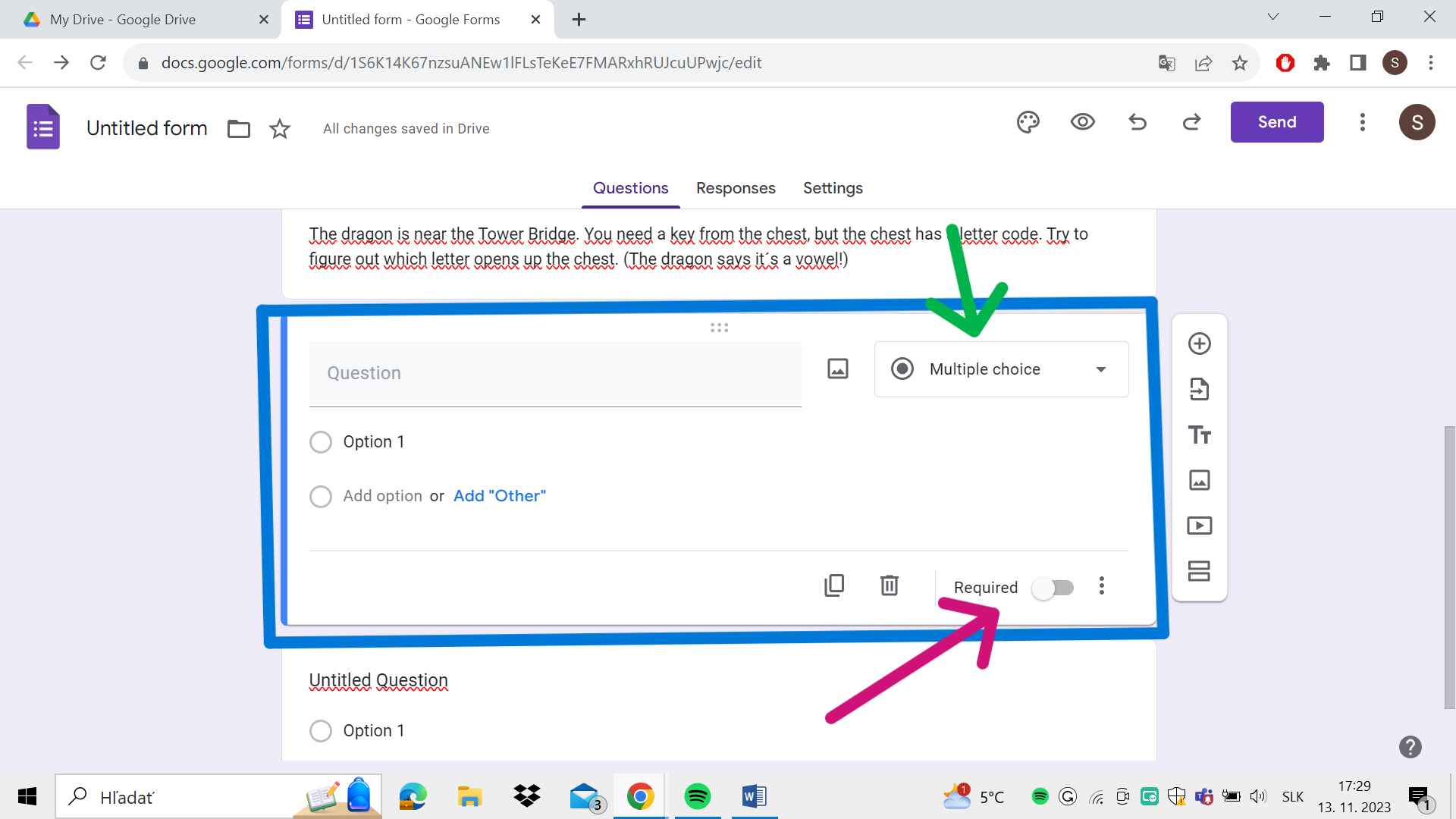
8. Based on what u chose, add answers to your question. By clicking on “Add option” under “Option 1” (last picture), you create answers.

9. Now, click on the 3 dots beside the “Required” mark and continue to “Go to section based on answer”. Here you can choose, which answer moves you forward and which gets you stuck in the same “room”.
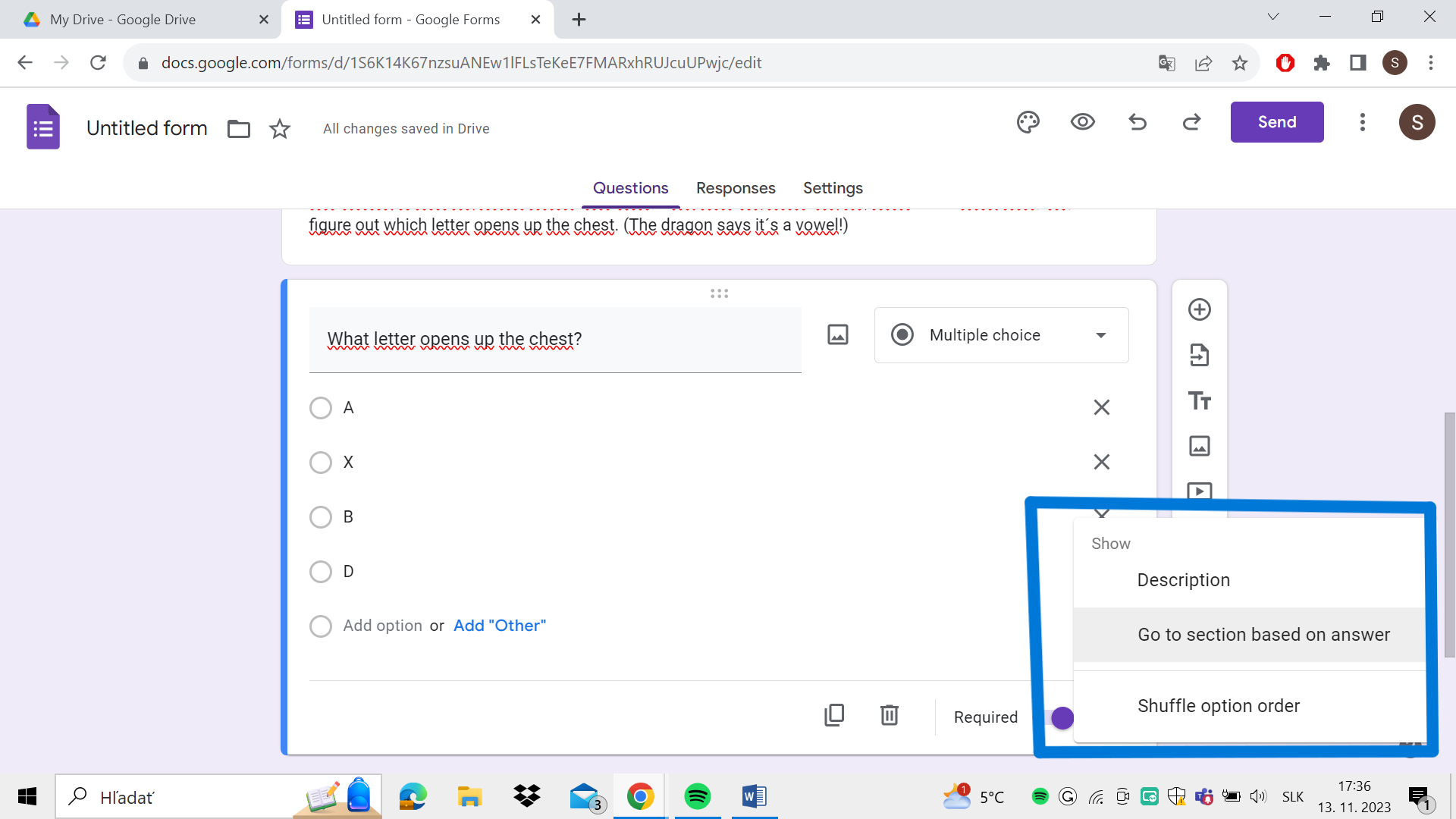
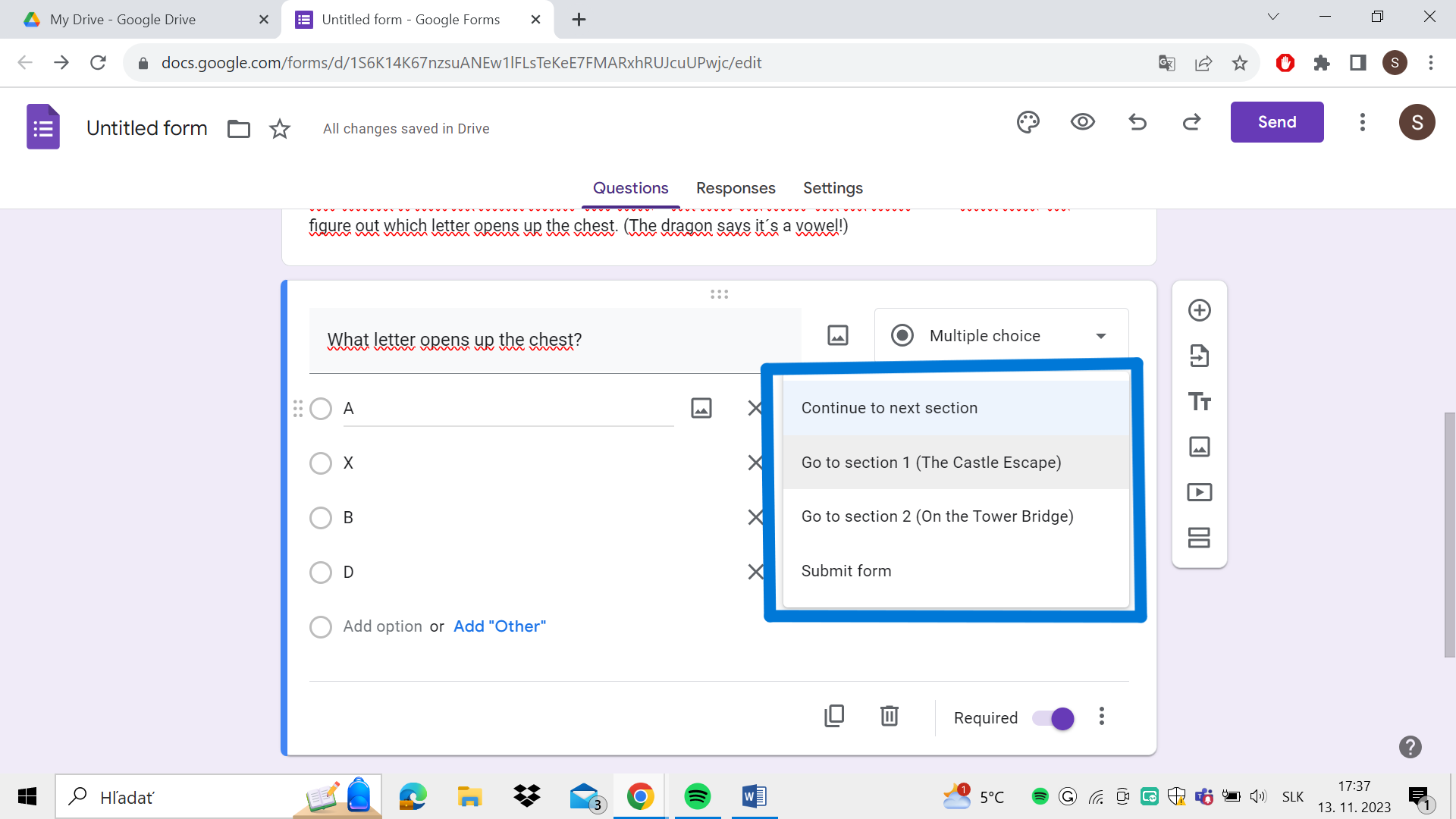
To move forward choose the “Continue to the next section” option beside the answer. Other should have “Go to section x” (The x stands for the section number the question is in, so if we are in section 2 question, the wrong answer should have “Go to section 2”). So the final look should be:
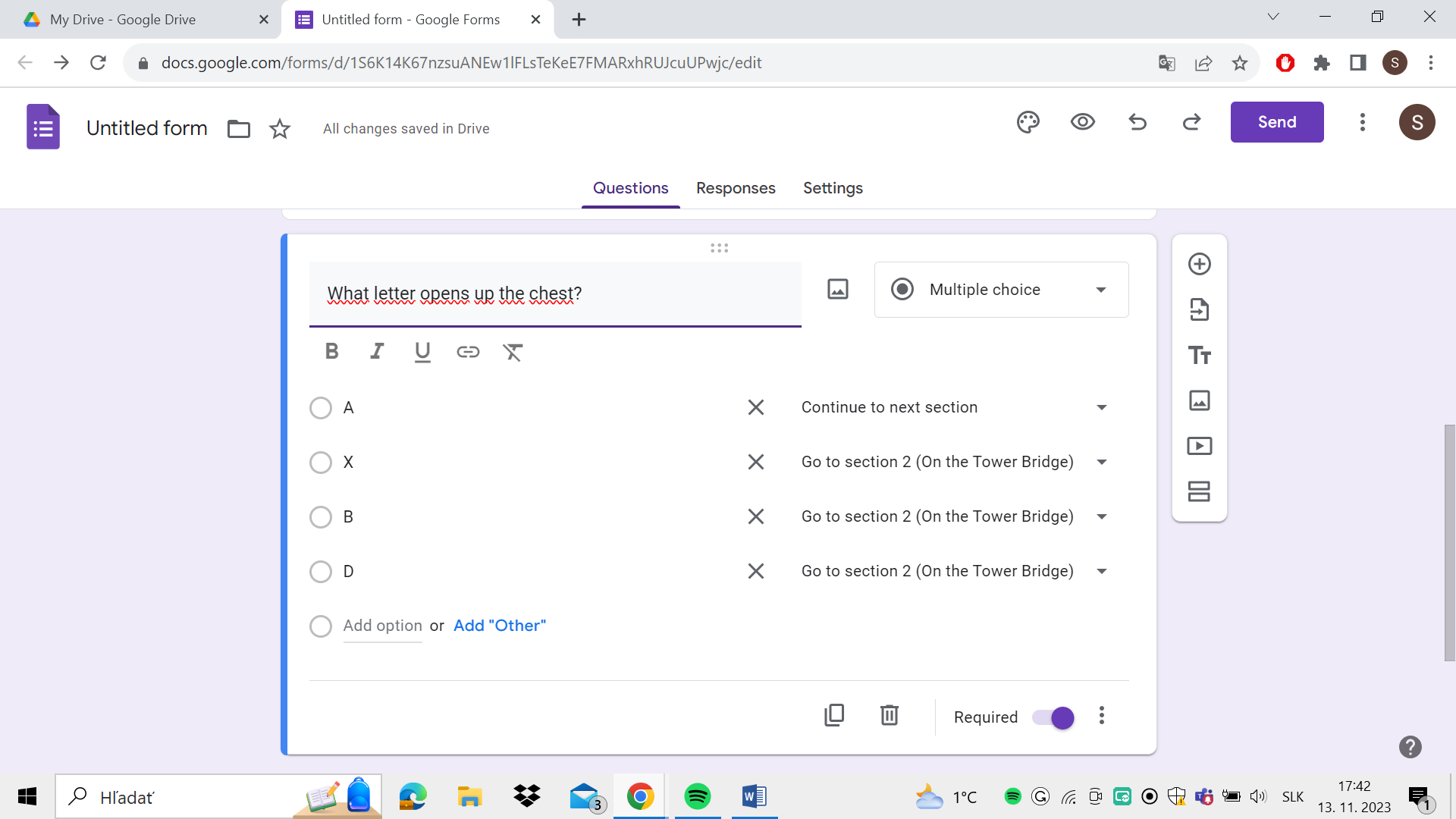
Congratulations, now you know how to do a question-based task in an escape room. Now let´s have a look at the text-based one.
10. To create a text-based question, you must first create a new section (Step 4), and then click on the “Multiple choice” box and choose the “Short answer” option. Also don’t forget to tick the “Required” option.

11. Create a question (To avoid misunderstandings, get the participants to answer in all caps), and then click on the 3 dots and go to “Response validation”
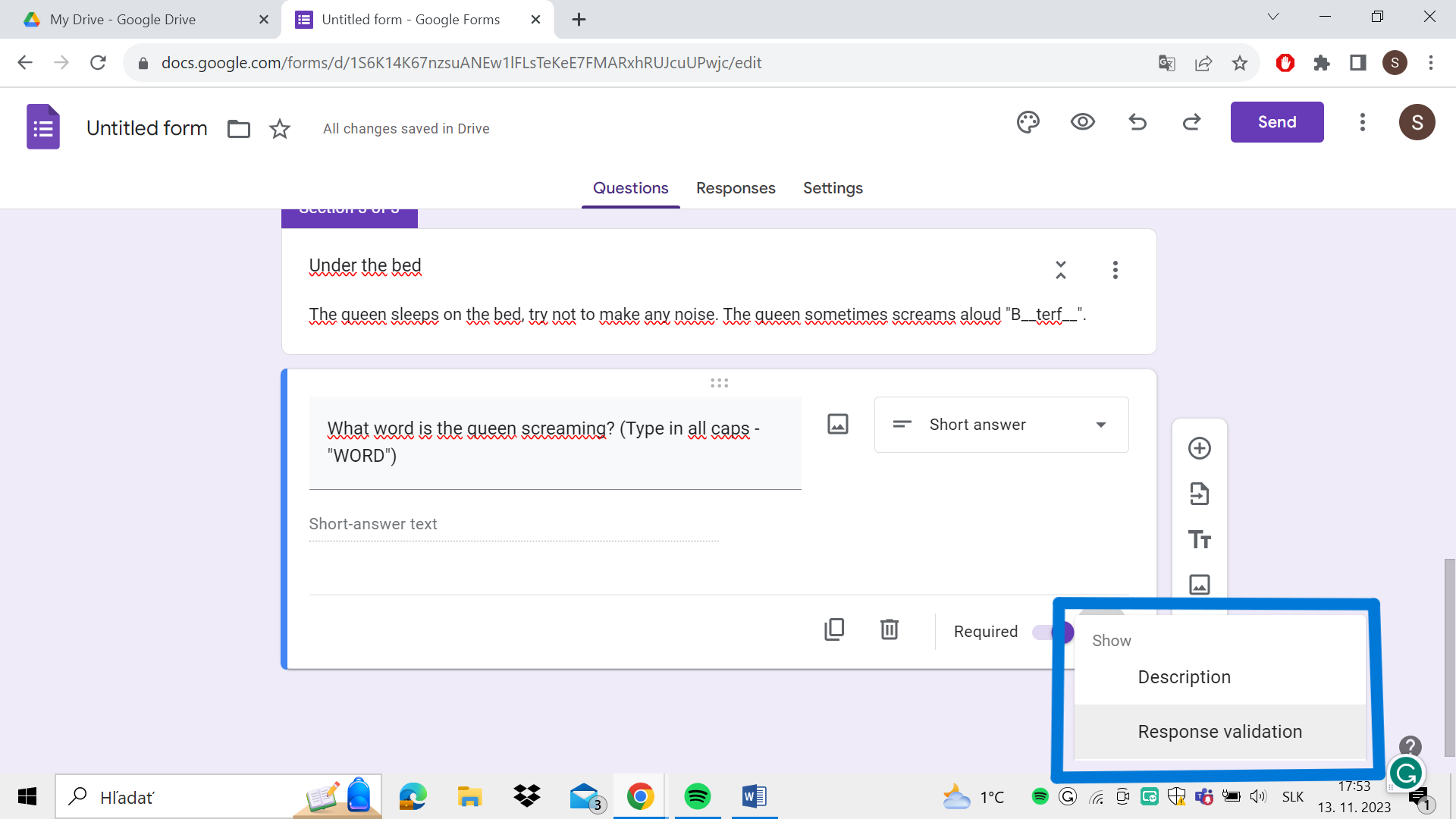
12. Change the “Number” option to “Text” and write down the answer in all caps. You can write down also a message if the participant gets the answer wrong.
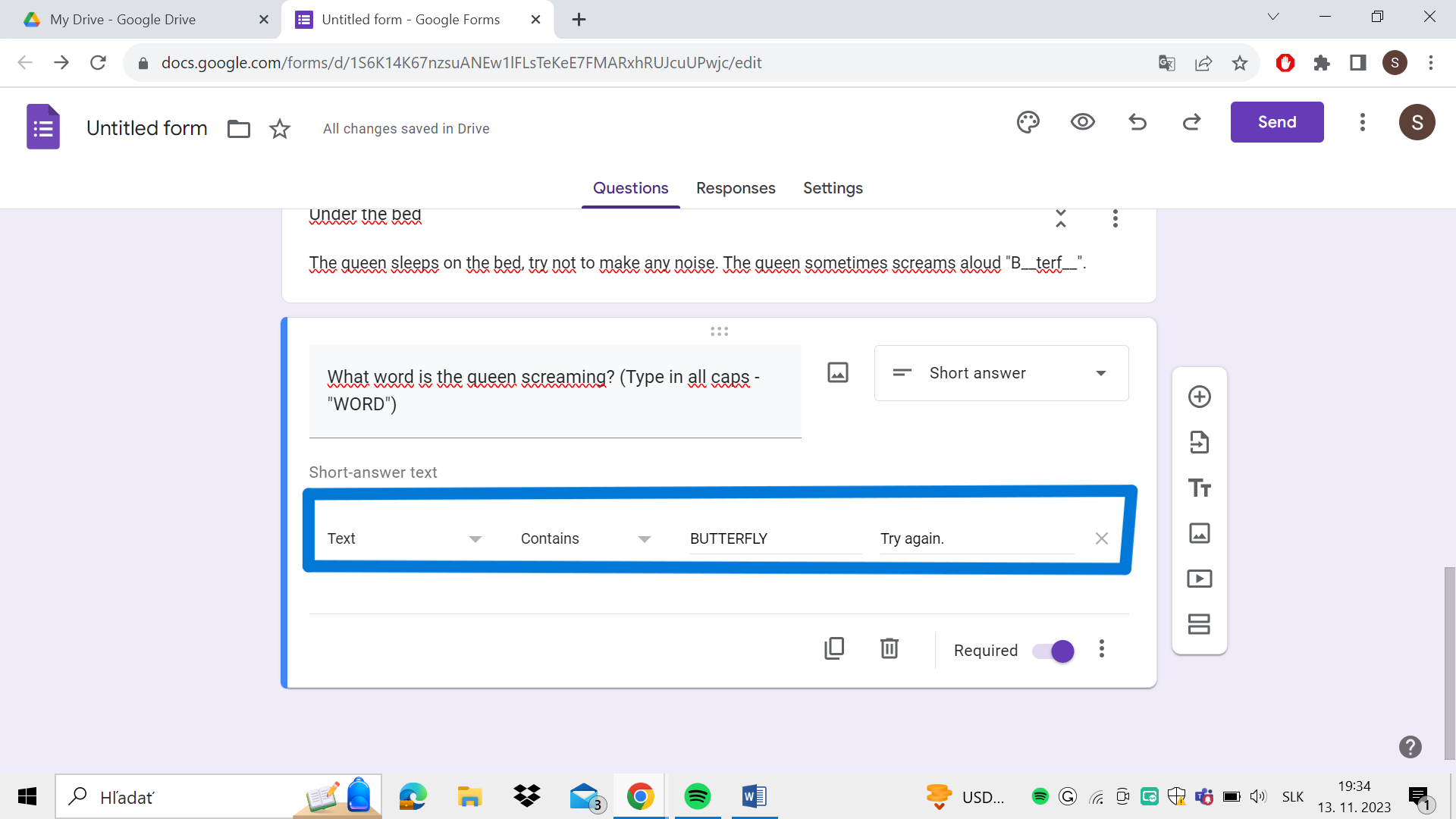
Congrats! Now you know how to make a text-based task for you escape room!
13. The last step consists of making it a quiz! So you get the answers of the participants right into your Google account! In order to do so, click on the Setting on the top and then click on the “Make this a quiz” box.
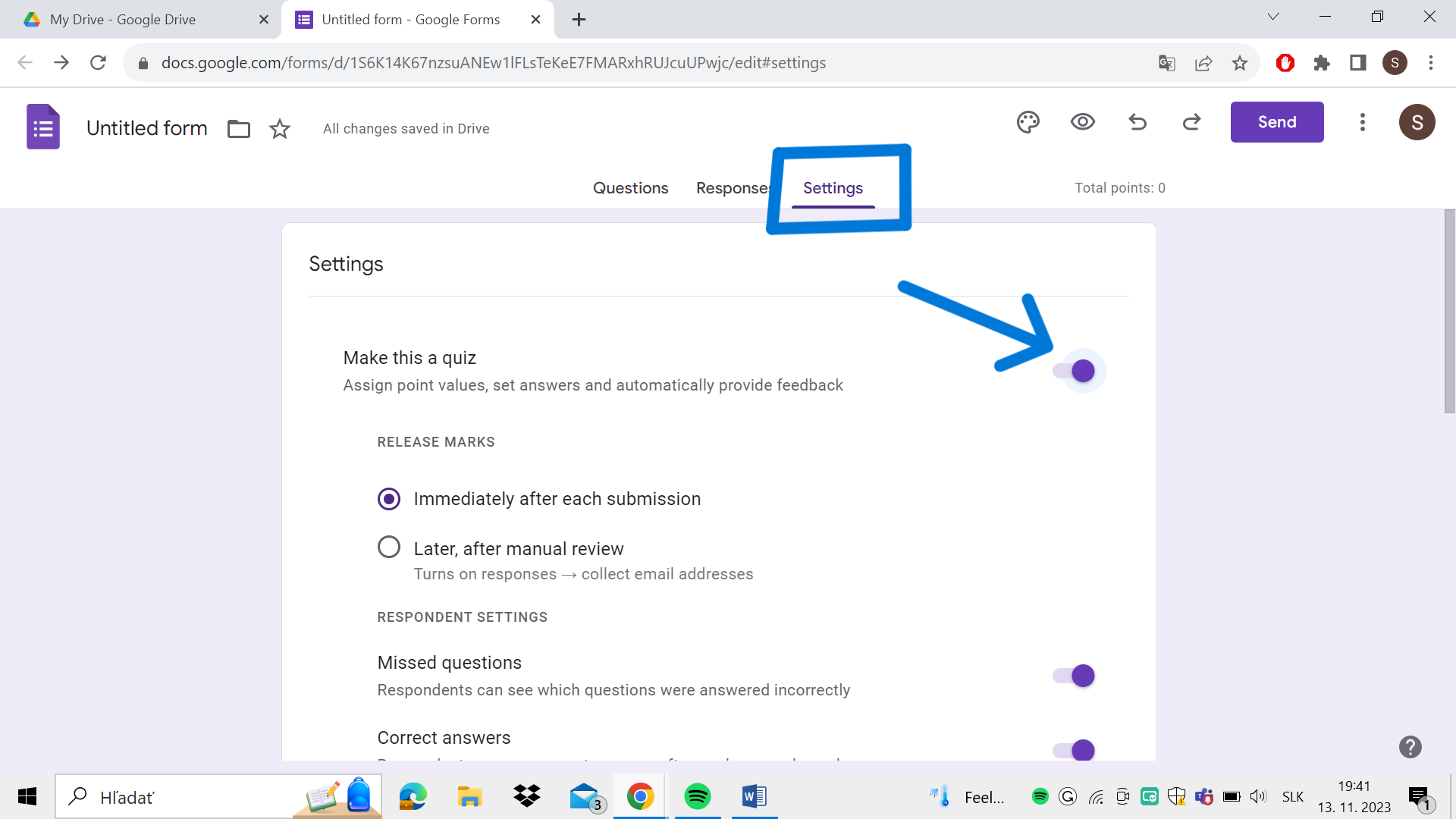
14. After
you´ve createed all of your tasks, click on the eye icon on the top and you can go
through your escape room and try it out yourself! 
These steps should help you with creating your own escape room! But it looks quite sad, doesn’t it? Let´s make it more lively by adding some colours!
Adding style to the Escape Room!
1. To make it more colourful, click on the colour pallet icon, beside the “Preview” (eye) icon
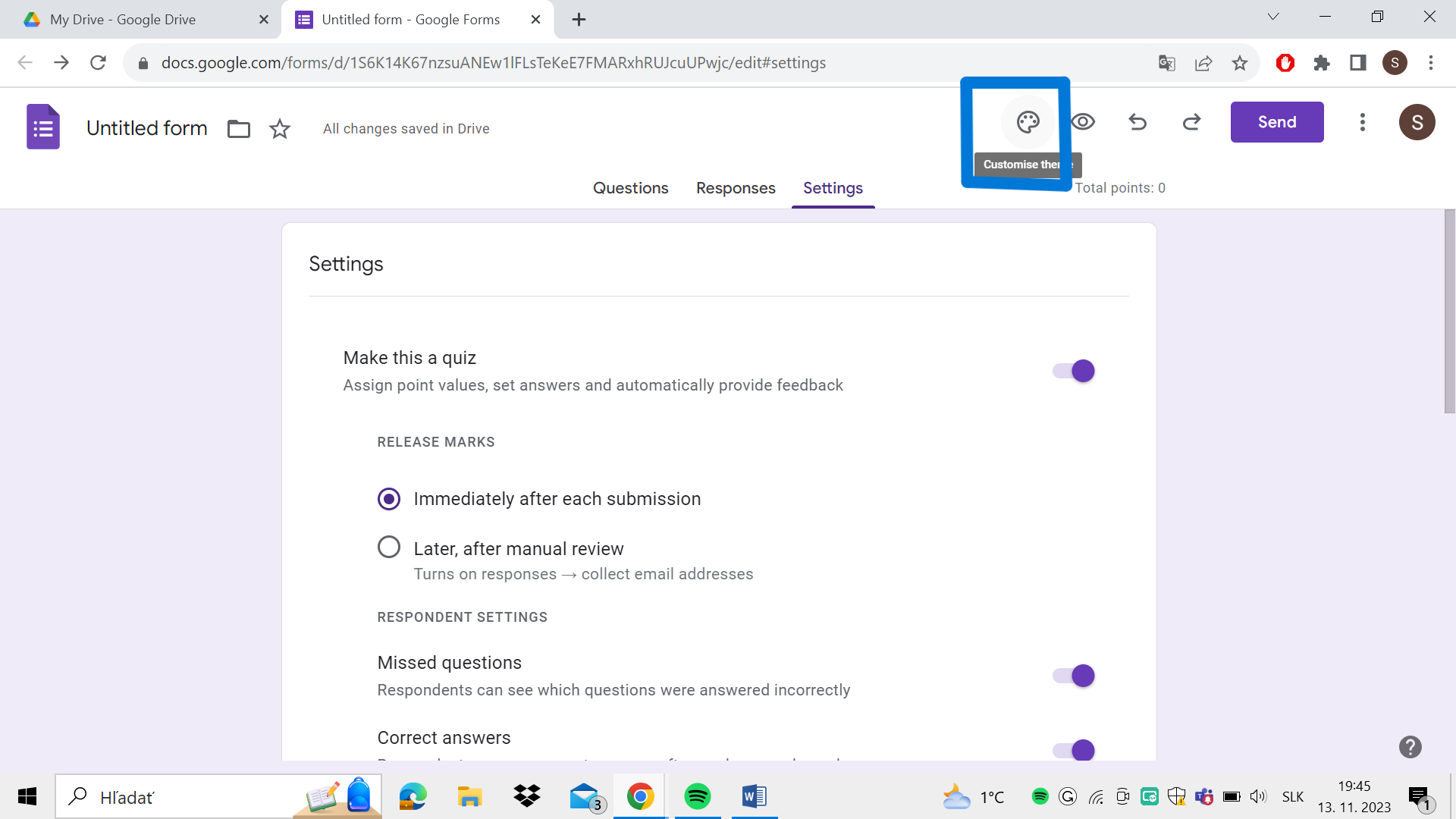
2. You can upload images as “Header”, change the font of the text, and its size and also choose colours of the background. For example, it can look like this.

Now, it’s your time to create an escape room! I hope these instructions helped you! Good luck and have fun! :)
7. Sample Escape Room Activity
This chapter contains a sample escape room activity. Click on the link and enjoy the escape room!
-> Escape Room <-